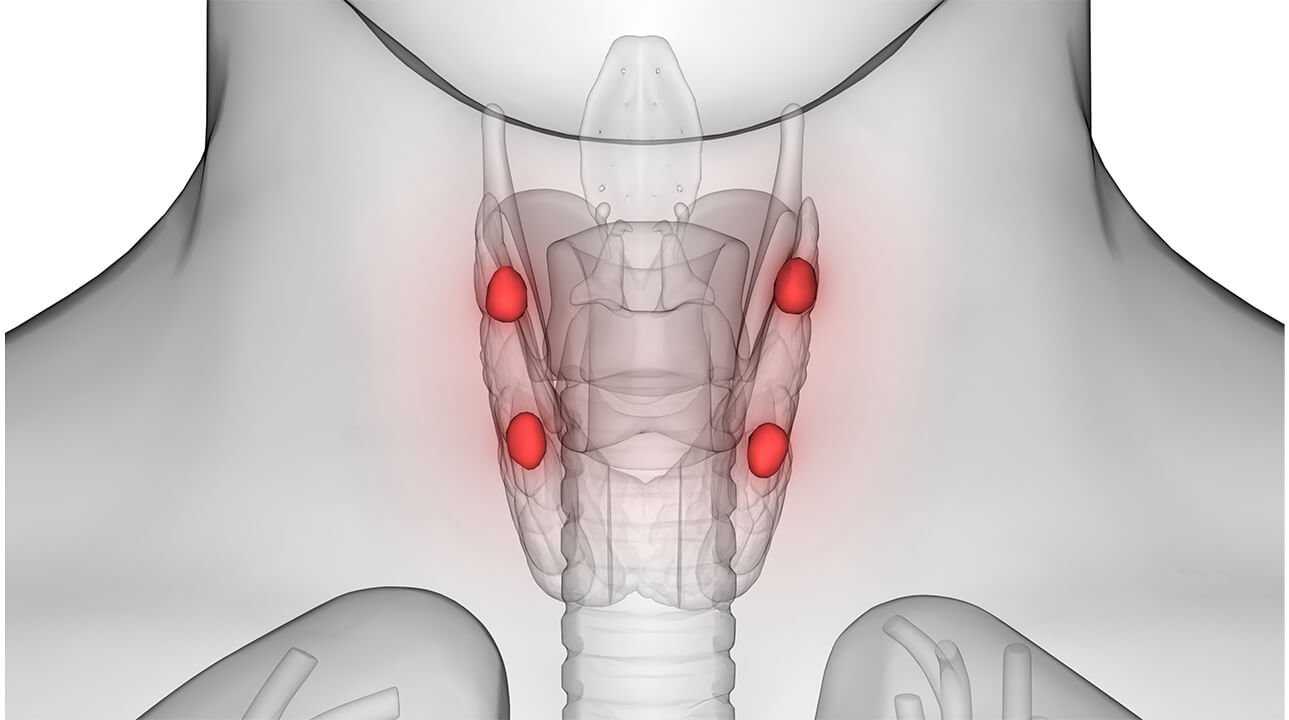Overview
What are parathyroids?
The parathyroid glands are actually four tiny glands that sit in the lower neck. They are found very near another gland in the neck called the thyroid gland. Although the parathyroid glands may lie very close to the thyroid or even be found inside of it, they have a very different function. While the thyroid regulates energy levels and growth, the parathyroid glands regulate calcium levels in your system.
The parathyroid glands regulate calcium in your body by making more or less of a hormone called parathormone (or PTH as it is also called). The parathyroid glands constantly measure calcium levels in the blood as it flows through them. If the calcium level gets high and is unsafe for your body, the normal glands sense this and decrease or stop their hormone production. This in turn lowers the calcium in your body and all returns to normal. Abnormal glands are unable to do this. They make too much hormone and continue to raise the blood calcium even when it is already very high.
What can go wrong with your parathyroid glands?
When one or more of your parathyroid glands become abnormal it is called hyperparathyroidism. In this situation, your gland (or glands) make too much (“hyper”) parathyroid hormone. Too much hormone raises blood calcium to unsafe levels. High blood calcium causes many symptoms and problems for your body including brittle bones, premature fractures, bone pain, general loss of energy or fatigue, depression, gastric reflux, kidney stones, and high blood pressure. In short, the bodily system has a major malfunction.
Instead of stopping the rising calcium as it should, the parathyroid gland only makes it go higher. This problem occurs because one (more rarely more) of the parathyroid glands stops working with the rest of the body. It develops a growth (also called an adenoma) and swells to a larger size. It no longer senses calcium levels in the blood and instead of listening to what the body needs, just keeps raising the calcium level. Like a “runaway train” the calcium level gets higher and higher and the symptoms and problems you experience get worse and worse. 97% of the time only one of the glands is the culprit. It develops a benign growth called a parathyroid adenoma.
Less commonly (2-2.5% of the time), a person will develop enlargement of all four glands. This is not an adenoma but is called hyperplasia. Even more rare is a condition where an individual will develop enlargement of just two glands, which is called “multiple adenomas”. And finally, much less than 1% of the time, a malignant growth may be found in the abnormal parathyroid.
What are the symptoms of parathyroid gland disease and what is the best treatment?
Parathyroid gland disease causes many problems. At first, individuals may be free of symptoms. But as the abnormality persists symptoms occur and they escalate. These may include:
- Premature thinning of the bones (osteopenia)
- Severe bone loss (osteoporosis)
- Bone fractures
- Kidney stones
- High blood pressure
- Gastric reflux
- Ulcers
- Bone pain
- Cardiac atrial arrhythmias (rare)
Some people may have had high blood calcium for several years before a parathyroid problem is suspected and identified. Many of these individuals will not have any of the major symptoms just described. In fact, many of these people don’t think they have any symptoms at all! Usually, however, they will have been experiencing some of the more nonspecific symptoms such as:
- Memory loss
- Low energy
- Vague aches and pains
- Muscle weakness in the legs
- Difficulty with concentration
- Feeling “out of sorts”
- Fatigue
- Depression
Unfortunately, people may often attribute these symptoms to “getting old” or “being out of shape” or “emotional issues” like depression. It is very important that high blood calcium be detected and evaluated. Even a slight elevation of calcium can be an early warning sign that diagnosis and treatment are needed.
There are two treatment options available to you: a watchful waiting approach or surgical removal.
Surgery is the only cure for primary hyperparathyroidism. Surgical removal is strongly advocated by physicians who frequently diagnose and recommend treatment for parathyroid disease.
If you are reading this section, then you or a loved one has probably been diagnosed with hyperparathyroidism and high blood calcium. With current advanced techniques, parathyroid surgery is very well tolerated and carries few complications. Furthermore, studies have shown that elderly patients enjoy the same benefits from successful parathyroid surgery as younger people do.
How do we identify the abnormal parathyroid glands?
Cervical Ultrasound and Nuclear Scintigraphy (Sestamibi Scan)
The traditional methods for parathyroid imaging are cervical ultrasound (US) and nuclear scintigraphy (sestamibi scan). These two imaging modalities are often used together to allow for identification and localization of the abnormal parathyroid gland. US enables precise anatomic localization and may be very accurate for normally positioned parathyroid adenomas. While the spatial resolution of a sestamibi scan is lower than that of US, it is able to identify parathyroid glands located outside of their normal position (i.e. upper neck or chest) that can be missed with US.
4D CT Parathyroid Scan
Four-dimensional CT has advantages in common to both US and scintigraphy. It provides excellent detail for preoperative localization, while the multiple phases show uptake characteristics that help to differentiate parathyroid lesions from lymph nodes and thyroid nodules.
How is parathyroid surgery usually performed?
Minimally Invasive Parathyroidectomy
Minimally invasive parathyroid surgery refers to the utilization of a small incision on the anterior neck, usually less than 2.5 cm. To select patients for minimally invasive parathyroidectomy surgery, the surgeon needs precise localization of the parathyroid adenoma and to exclude multiglandular disease.
The advantage of pre-operative localization is that it allows the surgeon to directly target a single gland for removal. Some surgeons may also use radio-guided (sestimibi detection with a gamma probe) to aid in adenoma localization during surgery.
Once the abnormal gland has been removed, intraoperative parathyroid hormone levels can be measured to determine if all abnormal glands have been resected. Further gland exploration is usually not needed.
The cure rates of minimally invasive parathyroidectomy surgery and four gland exploration are similar, but minimally invasive parathyroidectomy surgery has the advantages of better cosmetic results, shorter operating time and reduced complication rates.
Four Gland Parathyroid Exploration
Parathyroid glands can sometimes be difficult to find. Additionally, 30 percent of people can have more than one parathyroid adenoma that may not be identified with pre-operative imaging. If your affected parathyroid gland(s) cannot be located prior to surgery, all four of the glands (two on each side of the neck) will be explored during surgery with identification and removal of the abnormal gland(s). While this approach may require a larger incision, in most cases patients are discharged home the same day.
Providers

Grant R. Lohse, MD

DJ Wardle, DPM

Michael K. Gannon, MD

Justin P. Olsen, MD

Alan D. Barronian, MD

Niket Shrivastava, MD

Alexis Falicov, MD, PhD

William M. Hannay, MD
Locations
Proliance Sports Therapy & Rehab of Issaquah
1200 112th Ave NE Suite C260
Bellevue, WA 98004-3732
coordinates
Proliance Pacific Rim Physical Therapy
2075 Barkley Blvd. Suite 200
Bellingham, WA 98226
coordinates
Proliance Orthopedic Urgent Care – Covington
27005 168th Place SE Suite 201
Covington, WA 98042-4902
coordinates
Proliance Northwest Foot and Ankle Specialists
10821 19th Ave SE Suite 201
Everett, WA 98208
coordinates
Proliance Orthopedic Urgent Care – Kirkland
12911 120th Avenue NE Suite H-210
Kirkland, WA 98034-3061
coordinates
Bellingham Ambulatory Surgery Center
2075 Barkley Blvd. Suite 101
Bellingham, WA 98226
coordinates
Proliance Advanced Imaging Center
3101 Northup Way Suite 102
Bellevue, WA 98004-1469
coordinates
Proliance Ear Nose Throat & Allergy Associates
21911 76th Ave W Suite 211
Edmonds, WA 98026
coordinates
Proliance Orthopaedics & Sports Medicine
515 Minor Avenue Suite 200
Seattle, WA 98104
coordinates
Proliance Orthopedic Urgent Care – Tacoma
1724 W. Union Suite 100
Tacoma, WA 98405-2099
coordinates
Proliance Sports Therapy & Rehab of Bellevue
3101 Northup Way Suite 301
Bellevue, WA 98004-1449
coordinates
Proliance Orthopedic Urgent Care – Issaquah
510 8th Ave NE Suite 200
Issaquah, WA 98029-5436
coordinates
Proliance Orthopedic Urgent Care – Bellingham
2979 Squalicum Pkwy Suite 203
Bellingham, WA 98225
coordinates
Proliance Surgeons Puget Sound ENT
515 Minor Avenue Suite 140
Seattle, WA 98104
coordinates
Proliance Surgery Center at Valley
4009 Talbot Road S Suite 200
Renton, WA 98055-5772
coordinates
Proliance Pacific Rim Orthopedic Surgeons
2979 Squalicum Pkwy Suite 203
Bellingham, WA 98225
coordinates
Proliance Eastside Surgical Specialists
1231 116th Ave NE Suite 930
Bellevue, WA 98004-3804
coordinates
Proliance Surgeons Seattle Orthopedic Center-ASC
2409 N. 45th Street
Seattle, WA 98103-6907
coordinates
Proliance Plastic & Reconstructive Surgeons Ambulatory Surgery Center
17930 Talbot Road S.
Renton, WA 98055-6230
coordinates
Proliance Hillside Medical Surgery Center
104 27th Avenue SE
Puyallup, WA 98374-1145
coordinates
Proliance Eastside Surgery Center
12911 120th Avenue NE Suite H-110
Kirkland, WA 98034-3061
coordinates
Proliance Surgery Center at Rainier
3801 5th Street SE Suite 210
Puyallup, WA 98374-2106
coordinates
Proliance Southwest Seattle Surgery Center
275 SW 160th Street Suite 200
Burien, WA 98166-3003
coordinates
Proliance Edmonds Center for Outpatient Surgery
7320 216th Street SW Suite 140
Edmonds, WA 98026-8006
coordinates
Proliance Center for Specialty Surgery
515 Minor Avenue Suite 130
Seattle, WA 98104
coordinates
Proliance Puget Sound Surgery Center
7308 Bridgeport Way W. Suite 102
Lakewood, WA 98499-8000
coordinates
Proliance Everett Bone and Joint Surgery Center
1100 Pacific Avenue Suite 100
Everett, WA 98201-4261
coordinates
Proliance Center for Outpatient Spine and Joint Surgery
6808 220th Street SW Suite 100
Mountlake Terrace, WA 98043-2187
coordinates
Proliance Highlands Surgery Center
510 8th Ave NE Suite 100
Issaquah, WA 98029-5436
coordinates
Proliance Seattle Orthopedic Center Physical Therapy
2409 N. 45th Street
Seattle, WA 98103-6907
coordinates
Proliance Sports Therapy & Rehab of Bellevue
3101 Northup Way Suite 101
Bellevue, WA 98004-1449
coordinates
Proliance Seattle Orthopedic Center Physical Therapy
5350 Tallman Avenue Suite 500
Seattle, WA 98107-3932
coordinates
Proliance Sports Therapy & Rehab of Issaquah
510 8th Ave NE Suite 340
Issaquah, WA 98029-5436
coordinates
Proliance Physical & Hand Therapy Edmonds
7320 216th Street SW Suite 320
Edmonds, WA 98026-8006
coordinates
Proliance Seattle Orthopedic Center MRI
2409 N. 45th Street
Seattle, WA 98103-6907
coordinates
Proliance Eastside MRI
12911 120th Avenue NE Suite H-120
Kirkland, WA 98034-3061
coordinates
Proliance Puget Sound Imaging MRI
1724 W. Union Suite B100
Tacoma, WA 98405-2099
coordinates
Proliance Orthopedic Associates MRI
27005 168th Place SE Suite 301
Covington, WA 98042-4902
coordinates
Proliance ProSports Imaging NW MRI
3801 5th Street SE Suite 120
Puyallup, WA 98374-2106
coordinates
Proliance Advanced Imaging Center
510 8th Ave NE Suite 110
Issaquah, WA 98029-5436
coordinates
Proliance MRI North Puget Sound
6808 220th Street SW Suite 105
Mountlake Terrace, WA 98043-2187
coordinates
Proliance Orthopedic Associates MRI
8009 S 180th Street Suite 105
Kent, WA 98032-1042
coordinates
Proliance Surgeons Three Rivers Ear, Nose & Throat
7105 W. Hood Place Suite A103
Kennewick, WA 99336-6714
coordinates
Proliance South Seattle Otolaryngology
16259 Sylvester Road SW Suite 504
Burien, WA 98166
coordinates
Proliance Surgeons Seattle Spine Surgery
801 Broadway Suite 617
Seattle, WA 98122-4319
coordinates
Proliance Surgeons Seattle Spine Surgery
751 NE Blakely Drive Suite 4020
Issaquah, WA 98029-6201
coordinates
Proliance Surgeons Seattle Spine Surgery
20700 Bond Road NE Bldg B, Ste 105
Poulsbo, WA 98370-9099
coordinates
Proliance Rehabilitation, Sports & Spine Center
3216 Norton Avenue Suite 101
Everett, WA 98201-4290
coordinates
Proliance Rainier Orthopedic Institute
3801 5th Street SE Suite 110
Puyallup, WA 98374-2106
coordinates
Proliance Rainier Orthopedic Institute
20920 SR 410 E Suite 110
Bonney Lake, WA 98391-6302









